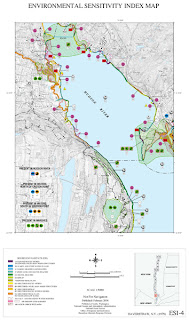There are many different kinds of maps that show
geographical patterns. In all types, a good map must have a title and a key, as
well as a scale and an indication of north. Beyond these basic standards, five
specific types, which will be explained below, are the choropleth map, the dot
density map, the isopleth map, the proportional symbol map, and the
environmental sensitivity map.
The choropleth map is the most common of the geographical
statistical maps. This type uses different colors, or different shades of the
same color, to indicate high, medium, and low areas of the data being
displayed. It is most often used to display data regarding rates, densities,
and percentages. This example of a
choropleth map, pictured above, shows diabetes hospitalization rates in
Massachusetts by ethnicity. As the key shows, this map indicates that the
darker the area, the more hospitalizations due to diabetes in that region.
The dot density map, as the name would indicate, uses dots
to show geographical patterns. Individual data points are shown on these maps
using a dot, and when all the dots are on the map together the patterns and
clusters of the data are easily visible. The dot density map above shows the
houses built in West Virginia during or before 1935. The clustering of the dots
make it easy to see in which parts of West Virginia there are the most of these
old houses.
The isopleth map, sometimes called the isoline map, portrays
continuous distribution using lines. These lines, called isolines, connect to
show ranges of equal value. Most often, this type of map is used to show
temperature or elevation. The example above uses lines, as well as color, to
map out the average maximum temperature across Ohio from 1971 to 2000. While the
various shades of red indicate various temperatures, the lines are also marked
with different temperatures, making it an isopleth map.

The proportional symbol map quite simply uses symbols that
are proportional to the data being displayed. For example, if the symbol being
used was a circle then a larger circle would indicate a larger value of the
date, whereas a smaller circle would indicate a smaller value. Any sort of
symbol can be used on this type of map, such as a circle, a square, or even a
symbol specifically related to the data being considered. In the example shown
above, circles of varying sizes are used to show the number of traffic
fatalities in each state in 2009. As is shown, the larger the circle is the
more fatalities that state had in that year.

Finally, the environmental sensitivity map shows the
environmental and cultural aspects in a specific region. This type of map takes
multiple datasets and combines them into one to show the areas of a region most
sensitive to development due to the resources or other assets present. These assets
can include anything from national parks to simply biodiversity. The environmental sensitivity map above shows the
Hudson River in New York. While a bit
difficult to see due to size, this map shows the different species found around
this river, as well as the different human resources that can be found.
In addition,
here is a video from National Geographic that shows the destructive powers of a hurricane.
Sources:
“Environmental
Sensitivity Mapping." British Geological Survey (BGS). Web. 04 Sept.
2012. <http://www.bgs.ac.uk/mineralsuk/sustainability/mapping.html>.
"Neighborhood
Statistics." Office for National Statistics. Web.
<http://www.neighbourhood.statistics.gov.uk/HTMLDocs/images/Statistical%20Maps%20-%20Best%20Practice%20v5_tcm97-51126.pdf>.












